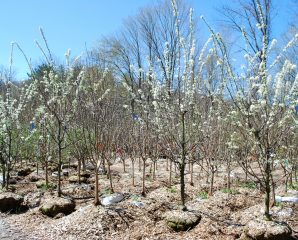Planting a vegetable garden is often high maintenance, but with trees and shrubs producing edible crops, one can have a fairly low-maintenance, attractive, edible landscape that’s great for the pollinators – especially honey bees! Planter’s Choice offers a growing selection of fruit trees. Most all are semi-dwarf allowing for ease of care and harvesting, and for fitting into backyard spaces. We have Apples (Malus Liberty, Honey Crisp, Gravenstein, Macintosh, Red Fuji, Golden Delicious, Yellow Transparent), Pears (Bartlett, Pyrus Hosui, Moonglow, Shinseiki, 20th Century), Cherries (Black York, Rainier, White Gold), Peaches (Red Haven, Belle of Georgia) and even Plums (Prunus ‘Superior’) as seen here. Some are limited in quantity, and the size assortment varies, so give either office a call for the current availability or click on Availability up top. All grow best in full sun. Fruit trees produce better harvests when they have a companion tree of the same species that blooms at the same time, allowing for cross-pollination. Even a tree labeled as “self fruiting” will still produce more fruit when cross-pollinated with a neighbor. Good to know – Crabapples will also cross pollinate Apples.
Plant your fruit trees in the sunniest open area, and perhaps border the garden with edible fruiting shrubs of Blueberry and Cranberry. Elderberry is another shrub that could be an accent piece, with both its flowers and berries used in cordials and other consumables. Blueberries might need some soil amendments to ensure the soil is acidic enough for them to thrive, although most of our area is naturally suitable for blueberries. A hedge of Blueberries could be underplanted with a row of Box Huckleberry or Wintergreen – both also prefer the acidic soil that Blueberries do. The bright red edible berries of Wintergreen might better balance the Blueberries above it, although they are harvested at separate times.
If the site hasn’t space for multiple fruit trees, then try an elegant espaliered apple or pear. That can be a tiered tree of one variety, or a couple varieties grafted together for a true “self-pollinating tree”. An espaliered tree requires more pruning and training than any other fruit tree, but it’s easy to do and truly adds a level of elegance like nothing else!
An edible landscape such as this shall, in short order, provide enjoyment in the form of an aesthetic landscape, color from the blooms and berries, and the delights of harvesting and eating fresh fruits within reach!
-Brenda

